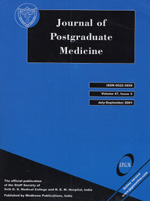
|
Journal of Postgraduate Medicine
Medknow Publications and Staff Society of Seth GS Medical College and KEM Hospital, Mumbai, India
ISSN: 0022-3859
EISSN: 0022-3859
Vol. 55, No. 4, 2009, pp. 252-256
|
 Bioline Code: jp09081
Bioline Code: jp09081
Full paper language: English
Document type: Research Article
Document available free of charge
|
|
|
Journal of Postgraduate Medicine, Vol. 55, No. 4, 2009, pp. 252-256
| en |
Aspirin resistance in Indian patients with coronary artery disease and cardiovascular events
Thomson, V. S.; John, B.; George, P.; Joseph, G. & Jose, J.
Abstract
Background : Aspirin resistance is a major problem and its incidence and clinical significance in Indian patients with documented coronary artery disease are not known.
Aim : We sought to study the incidence of aspirin resistance and its clinical significance in a cohort of Indian patients with coronary heart disease on therapy with aspirin using urinary 11-Dehydrothromboxane B2 levels as a surrogate marker for antiplatelet efficacy.
Setting and Design : Non randomized single center prospective study in cohort of patients with stable cardiovascular disease on chronic aspirin therapy attending the cardiology outpatient clinic of a tertiary care hospital.
Materials and Methods : Urinary dehydrothromboxane levels were analyzed in a cohort of 63 patients with stable documented coronary artery disease and in 21 healthy volunteers. The cases were followed up prospectively for a median period of 36 (1-53) months. The clinical endpoint was a composite of acute coronary syndrome, stroke, revascularization and death.
Statistical Analysis : Comparison of urinary dehydrothromboxane concentration values between various risk factors was done using Mann Whitney U test, a non parametric alternative of independent t test. All statistical analyses were done using SPSS 11.0 (Chicago, USA) software.
Results : The median (range) absolute values of urinary11- dehydrothromboxane B2 levels for the healthy volunteers and cases were 440 (286-2050) pg/ml and 320 (72-2600) pg/ml (P=0.007). The corresponding normalized values were 87.3 (43-143) and 60.8 (16.7-943) ng/mmol of creatinine (P=0.131). Among the various vascular risk factors, patients who were overweight had higher absolute levels of 11- urinary dehydrothomboxane B2 levels (P=0.016). There were significantly more clinical events in patients with absolute urinary 11-dehydrothromboxane B2 levels in the upper two quartiles compared to the lower two quartiles (P=0.04).
Conclusion : The incidence of aspirin resistance in the cohort of patients with documented heart disease was 38.1%. Patients with elevated absolute urinary dehydrothomboxane levels (>320 pg/ml) on chronic aspirin therapy constitute a high risk subset for recurrent vascular events.
Keywords
Aspirin resistance, myocardial infarction, platelet aggregation
|
| |
© Copyright 2009 Journal of Postgraduate Medicine.
Alternative site location: http://www.jpgmonline.com
|
|
